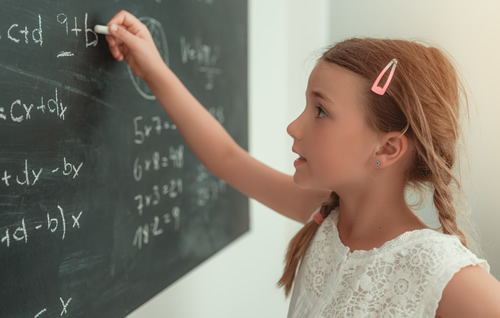“One of the challenges of teaching math, particularly in the United States, is that school math seems to come from a different universe than life math.” Attempts to bridge this “school math” with real-world math aren’t as hard as they seem, though—mathematicians are all around us.
In a recent edWebinar, Sara Delano Moore, Ph.D., director of professional learning for ORIGO Education, underscored that we, as educators, need to help students engage in math by seeing math–real-world math–as something vital to them.
Related content: How we created a growth mindset in math
Moore points out that there are formal mathematicians with advanced degrees and accreditations, but anyone who uses math and thinks about the world quantitively can be considered a mathematician.
Film stars using real-world math
Hedy Lamarr is best known as a film star from the 30s,40s, and 50s but also shares a 1942 patent on a frequency-hopping system currently known as Spread Spectrum Wireless. The coding for this system is credited with protecting warships sailing across the Atlantic in WWII. Instead of sending a signal across one frequency, the signal is spread across a range of frequencies (spread the spectrum) to make messages more stable and resistant to interference.
Football players
John Urschel, a former Baltimore Ravens player, left professional football in large part because using math he realized the set of risks associated with football-caused brain concussions. He went on to study mathematics at Massachusetts Institute of Technology. In his latest book, he said that he doesn’t care so much if a random person on the street knows the quadratic formula but that they can think through different problems, whether involving loans of two different rates or how much you need to put in your 401K.
Nurses
Florence Nightingale brought mathematics to the work of nursing when she invented Polar Area charts that represented the death of soldiers in a military hospital from April 1854 to March 1855 during the Crimean war. Using mathematics to inform the medical care of soldiers enabled Nightingale and her nursing staff to attend to not only battlefield wounds but the more significant numbers of medical conditions resulting from diseases, frostbite, and malnutrition.
Architects
The architect I.M. Pei composed famous buildings like the controversial pyramid at the Louvre in Paris that did not always reflect the historically designed buildings of the time. He is best known for designing from a geometrical perspective. When commissioned to design the East Wing of the National Gallery of Art in Washington, D.C., he partitioned the trapezoidal shape of the land into triangles that formed the girders and the design of the museum.
Moore hopes that when educators share stories of mathematicians, students can begin to see that math impacts so many different professions and parts of our lives. By broadening that scope, educators can help students understand what it means to be a mathematician and how we can all be mathematicians in fields that are interesting to us.
About the presenter
Sara Delano Moore, Ph.D. is the director of professional learning at ORIGO Education and a contributing author to Visible Learning for Mathematics. An experienced teacher and nationally recognized speaker, her work emphasizes the power of deep understanding and multiple representations for learning. Sara’s interests include building conceptual understanding of mathematics to support procedural fluency and applications, incorporating engaging literature into mathematics and science instruction, and connecting mathematics to engineering design in meaningful ways. She is a fourth-generation educator with experience teaching mathematics and science to K-8 students as well as experience teaching pre-service and in-service teachers at the university level. Sara earned her B.A. in natural sciences from Johns Hopkins University, her MSt in general linguistics and comparative philology from the University of Oxford, UK, and her Ph.D. in educational psychology from the University of Virginia.
Join the community
Mathematics for Young Learners is a free professional learning community on edWeb.net that provides a platform, advice and support in helping educators learn methods, ideas, and strategies to support mathematics development with young learners.
This edWeb broadcast was sponsored by ORIGO Education. The recording of the edWebinar can be viewed by anyone here.
- 3 ways to avoid summer learning loss - April 19, 2024
- High school students say AI will change the workforce - April 18, 2024
- Motivating students using the Self-Determination Theory - April 17, 2024


